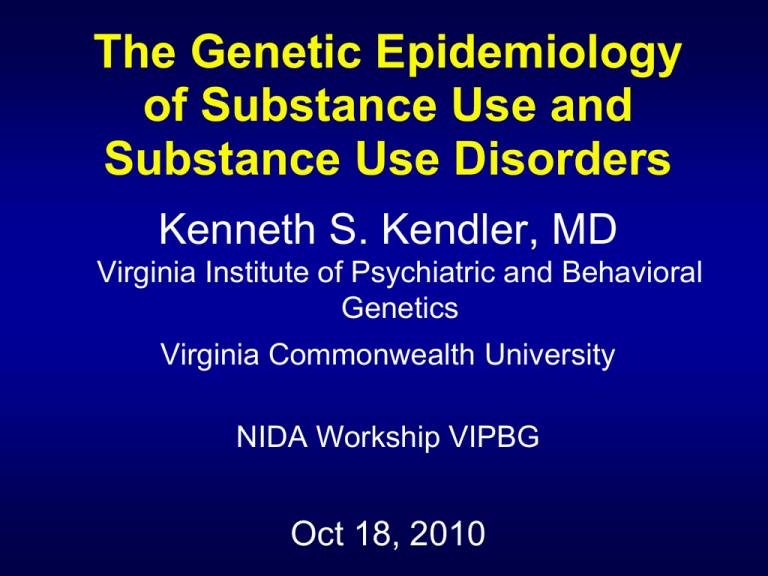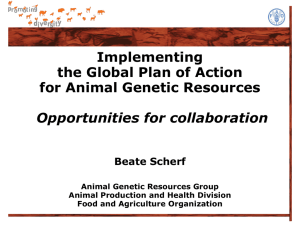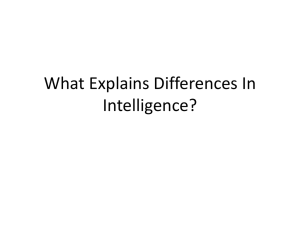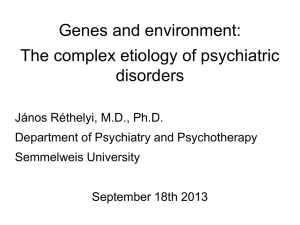
The Genetic Epidemiology
of Substance Use and
Substance Use Disorders
Kenneth S. Kendler, MD
Virginia Institute of Psychiatric and Behavioral
Genetics
Virginia Commonwealth University
NIDA Workship VIPBG
Oct 18, 2010
Outline of Talk
• 1. Review of paradigms in psychiatric
genetics
• 2. Basic genetic epidemiology
– Heritability of Substance Use Disorders
(AD).
– How stable over time and place?
Outline of Talk
• 3. Advanced genetic epidemiology
– Multivariate models of SUDs and other
psychiatric disorders
– Sex effects
– Development
– Cross-generational transmission
– Gene x environment interaction
– G-E correlation
– Integrated etiologic model of AD
– Multivariate model of DSM-IV AD criteria.
Paradigm 1- Basic Genetic
Epidemiology - What Have We
Learned?
• Genetic factors play a substantial role in the
etiology of Substance Use Disorders (AD).
• Heritability – the proportion of individual
differences in a particular disorder or trait in a
particular population that results from genetic
differences between individuals.
• Heritability estimates typically in the range of
50-60%
• How does this compare to other psychiatric
and biomedical disorders?
Heritability Of Psychiatric Disorders
Heritability
Psychiatric Disorders Other Important Familial Traits
~zero
Language
Religion
20-40%
Anxiety disorders,
Depression, Bulimia,
Personality Disorders
Myocardial Infarction,
Normative Personality, Breast
Cancer, Hip Fracture
40-60%
Alcohol Dependence
Drug Dependence
Blood Pressure, Asthma
Plasma cholesterol, Prostate
Cancer, Adult-onset diabetes
60-80%
Schizophrenia
Bipolar Illness
Weight,
Bone Mineral Density
80-100%
Autism
Height, Total Brain Volume
How Consistent are the Estimates of
Heritability of AD Across Space and
Time?
• Heritability is not a characteristic of a disorder
– rather it is a feature of a disorder in a
specific population at a specific time.
• We will look quickly at twin studies of AD and
other SUDs.
• First, a quick peak at adoption studies of AD
– only SUD for which we possess adoption
data.
Rates of alcoholism among adoptees
with and without biological alcoholic parents
Figure 1,
Prescott, Maes
& Kendler, 2005
Studies of male adoptees
Studies of female adoptees
Genetic & environmental proportions of variance in alcoholism
estimated from studies of male twins
Clinical sample
Figure 2a, Prescott, cotwin followup
Maes & Kendler, 2005
Population registry Volunteer registry
archival diagnosis personal interview
Genetic & environmental proportions of variance in alcoholism
estimated from studies of female twins
Clinical sample
Volunteer registry
cotwin follow-up Population registry personal interview
Figure 2b, Prescott,
Maes & Kendler, 2005
archival diagnosis
Summary Slide
• Based on published meta-analyses or ones we
did ourselves (with Joe Bienvenu) – pretty
large CIs.
• Main results of non-alcohol SUDs from two
studies – VATSPSUD and Vietnam Era twin
study. Some reports from the Australian and
Norwegian registiries.
How Consistent are the Estimates of
Heritability of AD Across Time?
• Swedish Temperance Board Registration
Data – 8,935 pairs of male-male twins born
1902-1949.
How Consistent are the Estimates of
Heritability of AD Across Space and
Time?
• Swedish Temperance Board Registration
Data – 8,935 pairs of male-male twins born
1902-1949.
• Complete birth cohort.
• Sweden underwent several dramatic
changes.
• Income increased 6-fold
• Government experimented with changes in
governmental control of access to alcohol.
How Consistent are the Estimates of
Heritability of AD Across Space and
Time?
• In 1917, Sweden adopted a nationwide
alcohol rationing system that strictly limited
the amount of alcohol that an individual was
permitted to purchase. An individual's official
limit varied according to sex, age, and
financial situations, and was, for men older
than 25 years, usually between 1 and 3 L of
hard liquor per month.
How Consistent are the Estimates of
Heritability of AD Across Space and
Time?
• So, to the best of our knowledge, the
heritability of AD is relatively robust – across
multiple European populations living in
Australia, North American and Europe and
across a half century of Swedish history that
saw dramatic changes in that country.
Paradigm 2- Advance Genetic
Epidemiology
• Many questions relevant to alcohol
dependence
• Begin with question of multivariate models –
• What is the relationship between the genetic
and environmental risk factors for SUDs and
for psychiatric disorders?
Paradigm 2- Advance Genetic
Epidemiology – Multivariate Models
• 7 common psychiatric and substance use
disorders assessed at personal interview in
over 5,600 male and female twin pairs from
the Virginia Adult Twin Study of Psychiatric
and Substance Use Disorder (VATSPSUD).
Paradigm 2- Advance Genetic
Epidemiology
• Sources of Comorbidity –Do genes respect
DSM-IV or ICD-10?
• Recall your As, Cs and Es
– A = additive genetic effects
– C = common or shared environment
F Family, school, peer or community effects that
make twins similar
– E = individual or unique environment
F “slings and arrows” experiences that make
twins different.
The full model for 7 common psychiatric and drug abuse disorders
Copyright restrictions may apply.
Kendler, K. S. et al. Arch Gen Psychiatry 2003;60:929-937.
Paradigm 2- Advance Genetic
Epidemiology – Multivariate Models
• AD and SUD form a common geneitic cluster
with CD and ASPD.
• Heritability of AD ~ 50%. Of this, around 70%
shared with externalizing disorders, 29%
unique to AD and 1% shared with
internalizing disorders.
• For SUD, heritability ~ 66% of which 64%
shared with externalizing disorders, 31%
unique to SUD and 5% shared with
internalizing disorders.
Paradigm 2- Advance Genetic
Epidemiology – Multivariate Models
• Re-examine this question in 2,111 personally
interviewed young adult members of the
Norwegian Institute of Public Health Twin
Panel. Statistical analyses were performed
with the Mx and Mplus programs.
Somatoform
.44
.65
Disorder
Panic Disorder
Major Depression
Agoraphobia
.88
.80
.81
.72
Generalized
Anxiety Disorder
Eating Disorders
Schizoid PD
.81
.71
Schizotypal PD
.67
Factor 1
Specific Phobia
Dysthymia
Axis I
.63
Axis II
.49
Internalizing
.56
Internalizing
.28
.23
.16
Factor 4
Axis I
Externalizing
.38
Axis II
.37
.48
Externalizing
.95
Drug Abuse /
Dependence
Alcohol Abuse /
Dependence
.87
.88
Conduct Disorder
.73
.84
.66
Dependent PD
.36
Factor 3
Antisocial PD
Social Phobia
.56
.36
.56
.61
.45
Avoidant PD
Factor 2
.51
.44
.35
Paranoid PD
Histrionic PD
Narcissistic PD
Obsessive –
Compulsive PD
Borderline PD
Paradigm 2- Advance Genetic
Epidemiology – Multivariate Models
• So, we replicate results – AD and SUD are
genetically part of the externalizing group of
disorders.
Paradigm 2- Advance Genetic
Epidemiology – Multivariate Models
• Let’s drill down deeper into the relationship
between AD and SUD to directly address the
question of the specificity or non-specificity of
genetic risk factors for AD.
.82
Illicit Substance
Genetic Factor
Licit Substance
Genetic Factor
.82
.77
.68
.15
.52
Cannabis
Dependence
Cocaine
Dependence
Alcohol
Dependence
Caffeine
Dependence
Nicotine
Dependence
.20
A
.31
A
.35
A
.56
A
.68
A
E1
.27
.48
.37
.14
.18
Cannabis
Dependence
Cocaine
Dependence
Alcohol
Dependence
Caffeine
Dependence
Nicotine
Dependence
.47
.28
.53
.80
.48
E
E
E
E
E
Paradigm 2- Advance Genetic
Epidemiology – Multivariate Models
• Similar to prior analyses from this sample,
these results suggest that ~ 70% of heritabiity
for AD is shared (this time with other drugs of
abuse) and 30% unique to AD.
• For cocaine dependence, for example, 85%
of total heritability is shared with other drugs
and 15% is unique.
• In general, pretty clear that non-specific
genetic effects outweigh specific effects.
Paradigm 2- Advance Genetic
Epidemiology – Sex Effects
• Sex can impact on genetic effects in two
ways.
• Quantitative effects – genetic effects stronger
in one sex than the other.
• Qualitative effects – different genetic risk
factors operating in the two sexes.
– One extreme - sex-specific gene
expression
– Examples – genetic risks for breast and
prostate cancer
Paradigm 2- Advance Genetic
Epidemiology – Sex Effects
• In our large Virginia twin study, where we
over-sampled opposite sex DZ twins, we
found
– Modest evidence for quantitative sex
effects: heritability of AD is slightly higher
in females than males.
– Strong evidence for qualitative sex effects.
Genetic correlation in risk between men
and women for AD estimated at ~ +0.48.
Paradigm 2- Advance Genetic
Epidemiology – Development
• Genes and environment act through time.
• Focus on alcohol intake in 1796 members of
male-male pairs from the Virginia Adult Twin
Study of Psychiatric and Substance Use
Disorders.
• Assessed retrospectively
history calendar.
using a life-
The frequency of any use of caffeine, alcohol, nicotine, and cannabis by year from ages 9 to 41
years
Kendler, K. S. et al. Arch Gen Psychiatry 2008;65:674-682.
Copyright restrictions may apply.
NICOTINE
Paradigm 2- Advance Genetic
Epidemiology – Development
• One more developmental question –
• Do we see differential developmental
changes in the impact of specific genetic risk
factors for AD versus non-specific risk factors
for externalizing disorders.
• Again ~ 1700 males from VATSPSUD
Regression Coefficients Predicting
Alcohol Intake
0.25
0.2
Genetic Risk for
Alcohol
Dependence
0.15
0.1
Genetic Risk for
Externalizing
Disorders
0.05
0
12-14 15-17 18-21 22-25 26-29 30-33
Age
Paradigm 2- Advance Genetic
Epidemiology
• Twin-family designs – ask a new set of
questions.
Paradigm 2- Advance Genetic
Epidemiology
• How to capture the conditionality of genetic
influences on SUDs.
• No initiation, no chance to express genetic
risk.
• How to model?
• CCC model – causal, contingent, common
pathway.
Paradigm 2- Advance Genetic
Epidemiology – Gene x Environment
Interaction
• Definition – the impact of genetic risk factors
on disease risk is dependent on the history of
environmental exposures. OR
• – the impact of environment risk factors on
disease risk is dependent on genotype.
• Probably no area of psychiatric genetics
research that is more controversial and
artifact prone.
• A range of conceptual and statistical issues Buyer beware!
Paradigm 2- Advance Genetic
Epidemiology – Gene x Environment
Interaction
• Again ~ 1700 males from VATSPSUD
• Asked – would the heritability of alcohol
consumption in adolescence be modified by
key environmental risk factors
– Alcohol Availability
– Peer Deviance
– Prosocial Behaviors
Drinks/mo (z)
Alcohol Availability 12-14
0.4
0.3
0.2
0.1
0
-0.1
-0.2
-0.3
Alc Avl=+1 sd
Alc Avl=mean
Alc Avl=-1 sd
Genetic Risk AD
Drinks/mo (z)
Peer Group Deviance 12-14
0.4
0.3
0.2
0.1
0
-0.1
-0.2
-0.3
PGD=+1 sd
PGD=mean
PGD=-1 sd
Genetic Risk ExtD
Drinks/mo (z)
Lack of Prosocial Activities 12-14
0.4
0.3
0.2
0.1
0
-0.1
-0.2
-0.3
LPSA=+1 sd
LPSA=mean
LPSA=-1 sd
Genetic Risk ExtD
Paradigm 2- Advance Genetic
Epidemiology – Gene x Environment
Interaction
• Many other interesting G x E findings for
alcohol use.
• A few other examples.
• One general theme – Genetic effects on
alcohol use are more pronounced when
social constraints are minimized and/or when
the environment permits easy access to
alcohol and/or encourage its use.
Gene-Environment Interaction
Alcohol Use
• Marital Status (Heath et al., 1989)
• Religiosity (Koopmans et al., 1999)
• Urban/rural residency (Rose et al., 2001)
• Neighborhood characteristics (Dick et al.,
2001)
• Parenting/Peers (Dick et al., 2006, 2007)
The Creation of our Social World
Through Development
• Measures of peer group deviance
retrospectively reported by a life history
method.
• ~750 male-male twin pairs.
• Five ages assessed.
Mean
Variance
MZ-ICC
DZ-ICC
8-11
4.49
18.52
0.66
0.47
12-14
7.48
38.03
0.68
0.43
15-17
11.39
45.78
0.67
0.40
18-21
14.04
49.02
0.66
0.39
22-25
13.35
48.68
0.65
0.39
Peer Group Deviance
25
20
A
C
E
15
10
5
0
8-11
12-14
15-17
Ages
18-21
22-25
Genetics of Nicotine Dependence
• Here we have “real” candidate genes.
• Last year has seen a series of quite
consistent findings for a tight block of nicotine
receptor genes on chromosome 15q25.
Gene-Environment Correlation
• Several studies have now shown that these
same set of variants in the nicotinic receptor
genes impact on risk for adenocarcinoma of
the lung. What is going on here?
• Genetic variant → greater pleasurable effects
from nicotine → increased risk for nicotine
dependence → seeking cigarettes in the
environment → greater exposure to cigarette
smoke → increased risk of lung carcinoma.
• A strange kind of oncogene!
Paradigm 2- Advance Genetic
Epidemiology
• Integrated etiologic models.
• To just get a start looking at causal pathways.
.37
.18
.08
Genetic Risk
Genetic Risk
Alcoholism
Ext Disorders
.17
.27
.18
.08
.12
.17
.27
Alcohol
Parental
Childhood Phys
Attendance
Household Use
Alcohol Attitude
Sexual Abuse
.13
.24
.07
.06
.22
-.10
.07
ADHD
.30
.34
Low Church
.06
.21
Birth Year
.19
-.06
.23
Neuroticism
.06
.14
.10
.27
.08
.09
.08
.06
.09
.13
.07
.08
.32
.13
.14
Sensation
Early Onset
Seeking
Anxiety Disorder
.37
.23
.23
.08
.07
.06
.08
-.08
.06
.06
.30
.14
.15
.08
.08
.13
-.06
Conduct
Low Parental
Peer Group
Alcohol
Disorder 15-17
Monitoring 15-17
Deviance 15-17
Availability 15-17
.12
-.06
-.06
.05
.12
.09
.09
.15
.30
Alcohol Use 15-17
.10
.16
.26
.08
.06
.07
.24
.12
Symptoms of Alcohol
Use Disorders
.37
Genetic Risk
Genetic Risk
Alcoholism
Ext Disorders
Low Church
Alcohol
Parental
Childhood Phys
Attendance
Household Use
Alcohol Attitude
Sexual Abuse
Birth Year
.21
.23
ADHD
Neuroticism
Sensation
Early Onset
Seeking
Anxiety Disorder
.37
.30
.22
.10
.07
.08
Conduct
Low Parental
Peer Group
Alcohol
Disorder 15-17
Monitoring 15-17
Deviance 15-17
Availability 15-17
.12
.05
-.06
.10
.30
Alcohol Use 15-17
.26
.07
.06
.24
Symptoms of Alcohol
Use Disorders
Genetic Risk
Genetic Risk
Alcoholism
Ext Disorders
Birth Year
.27
.34
.12
.17
Low Church
Alcohol
Parental
Childhood Phys
Attendance
Household Use
Alcohol Attitude
Sexual Abuse
ADHD
Neuroticism
Sensation
Early Onset
Seeking
Anxiety Disorder
.14
.08
.08
.13
.23
.06
.08
.06
.30
.14
.15
Conduct
Low Parental
Peer Group
Alcohol
Disorder 15-17
Monitoring 15-17
Deviance 15-17
Availability 15-17
.09
.12
.09
.08
.30
Alcohol Use 15-17
.16
.26
Symptoms of Alcohol
Use Disorders
.13
Paradigm 2- Advance Genetic
Epidemiology – Integrative
Developmental Model
• Evidence for two etiologic pathways
characterized by genetic and temperamental
factors and by psychosocial adversity.
Paradigm 2- Advance Genetic
Epidemiology – Multivariate Model
for DSM-IV Criteria for AD
• Attempted to distinguish two hypotheses.
• 1. Each of the seven AD criteria index the
same set of risk genes so that the diagnosis
of AD is genetically homogeneous.
• 2. The DSM-IV syndrome of AD is genetically
heterogeneous, arising from multiple sets of
risk genes that are each reflected by a distinct
set of diagnostic criteria.
– Rodent studies suggest relatively distinct
set of risk genes for different alcoholrelated traits.
Paradigm 2- Advance Genetic
Epidemiology – Multivariate Model
for DSM-IV Criteria for AD
• Long arduous task of complex model fitting.
• 7,548 personally interviewed male and female
twins from the Virginia Adult Twin Study of
Psychiatric and Substance Use Disorders
• Had to take account of the fact that lots of
people did not meet our screening criteria and
skipped out of the alcohol section.
• This is the best fit model --
A1
.67
.22
.29
Excessive
Quantity /
Frequency
.17
.36
.51
ES1
.42
.51
.26
Perception
of Alcohol
Problem
.22
.67
.01
ES2
.54
A2
.30
.24
Tolerance
.58
.19
.43
.33
.30
.54
Withdrawal
.45
ES3
.33
.45
ES4
E1
.30
.43
A3
.33
Loss of
Control
.63
.28
.19
.50
.27
ES5
.58
.28
.51
.28
Preoccu-
Desire to
Quit
.39
.50
pation
.47
ES6
E2
.41
.34
.36
ES7
.33
.48
.44
Activities
Given Up
.30
.45
.42
ES8
.29
.38
.47
Continued
Use Despite
Problems
.34
.29
.59
ES9
Paradigm 2- Advance Genetic
Epidemiology – Multivariate Model
for DSM-IV Criteria for AD
• This is the best fit model –
• Robustly supported second hypothesis –
evidence for three genetic factors, which we
tentatively called:
– heavy use and tolerance
– loss of control with alcohol associated
social dysfunction
– withdrawal and continued use despite
known problems.
8 Major Conclusions
• 1. SUDs are substantially heritable and
heritability estimates at least for AD appear to
be relatively stable across time and space.
• 2. Roughly 2/3rds of genetic risk factors for
AD and other SUDs are not-disorder specific
but are shared with other externalizing
disorders generally and other forms of
substance abuse more specifically.
• 3. In early adolescence, siblings
resemblance for alcohol and nicotine
consumption is entirely due to environmental
factors. With increasing age, we see an
increasing degree of genetic influence.
Conclusions
• 4. For at least AD, we do not have strong
evidence from GE models for parent-offspring
environmental transmission.
• 5. Genes for AD appear to be rather
substantially moderated by environmental
exposures, especially those which either relax
social constraints and/or permit easy access
to alcohol and/or encourage its use.
Conclusions
• 6. G-E correlation is probably an important
etiologic factor in SUDs. Genes can impact
on SUDs via outside the skin pathways.
• 7. I presented one very rough integrated
etiologic model for AD – showing how
genetic/termpermental and environmental
adversity pathways might inter-relate in the
etiology.
• 8. DSM-IV criteria for AD appear, from a
genetic perspective, to be etiologically
complex reflecting multiple dimensions of
genetic risk. Would we see the same for other
SUDs?
Key Collaborators
• Mike Neale PhD
• Danielle Dick PhD
• Carol Prescott PhD
• Hermine Maes PhD
• Charles Gardner PhD
• Steve Aggen PhD
• John Myers MA
• Ted Reichborn-Kjennerud
MD
Support
• NIAAA
• Our NIAAA funded Alcohol Research Center
at VCU
• NIDA
• NIMH
• Rachel Banks Endowment Funds
• Virginia Commonwealth University’s
generous support for the Virginia Institute for
Psychiatric and Behavioral Genetics
• No conflicts of interest










